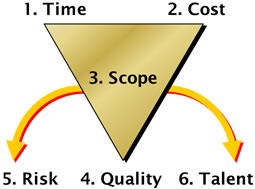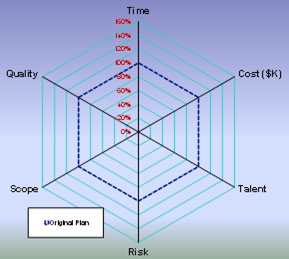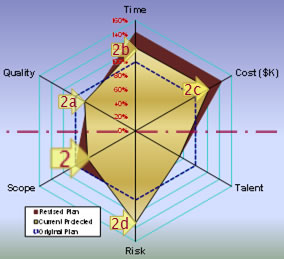Manage the Leading Factors: We have just returned from the outstanding-as-usual 2012 Resource Planning Summit, organized by the irrepressible Dick Rutledge. I view Dick to be the dean of the PM-related conference providers. Only a few others operate at the same level of excellence. One of the key differentiators of Rutledge’s events is his ruthless demands of his speakers. He insists that we provide clear and valuable audience take-aways, and truly new ideas, as opposed to retreads of tired themes. This time, I experienced those demands first-hand, as I was a presenter–my first opportunity in the four events I have supported.
I targeted my presentation, Tip of the Iceberg: Managing the Entire ‘berg Improves PM Performance, for his audience of key managers and enterprise leaders. It covered project decision-making from the perspective of top Executives–the tip of the iceberg. I identified key practices that Managers in the Middle follow when they add clear value for their executives, project teams and their organizations.
I asserted, as in our article, Project Levers and Gauges, that the most-effective project managers don’t just provide lagging data, they also provide leading information. And, we carried the theme further, pointing out that this leading information is a well-kept secret of the most effective managers of project managers.
Background
But, let’s start with the background. Many are familiar with the old misconceptions of project management, illustrated by the Triple Constraint, or the Iron or Golden Triangle. It often includes Time, Cost and Scope. Sometimes Quality is there instead of Scope. Sometimes Performance is the third parameter, which might include Quality and Scope. So far, so good; but why do we call this a misconception in project management?
 Because, while those often-named factors are important, there is one huge differentiator of competent, performing project managers. That differentiator is which factors you manage, and which you monitor. Less-effective PMs try to control the easy to measure, but lagging factors. We understood this weakness in the early 1980s when we published the Project Vital Signs, shown at right. Yes, there are more than three of them, and our assertion then and through today is that one must manage all of them.
Because, while those often-named factors are important, there is one huge differentiator of competent, performing project managers. That differentiator is which factors you manage, and which you monitor. Less-effective PMs try to control the easy to measure, but lagging factors. We understood this weakness in the early 1980s when we published the Project Vital Signs, shown at right. Yes, there are more than three of them, and our assertion then and through today is that one must manage all of them.
Some of these factors may look familiar to you, because they are similar to the knowledge areas in Max Wideman’s 1986 PMBOK®. By the way, we originally called #6 Resources; for the last ten years we have called it Talent. But this is just background on the most-discussed part of our Resource Planning Summit presentation.
Planning Leading and Lagging Factors
 In 1985 we began helping our customers to track measures or indicators for each of these “vital signs.” The measures varied with the organization, because some had no reliable measurements in a few of the areas. When a project’s Baseline was established, we captured that baseline across all factors as 100%, as shown at left.
In 1985 we began helping our customers to track measures or indicators for each of these “vital signs.” The measures varied with the organization, because some had no reliable measurements in a few of the areas. When a project’s Baseline was established, we captured that baseline across all factors as 100%, as shown at left.
Today, when we show this diagram, the first question of most savvy managers is “how do we measure the Talent, Scope and Risk?” As mentioned above, these vary with the organization, and with their ability to measure these harder-to-quantify factors. But even the Time and Cost factors must be evaluated against true baselines, rather than arbitrary deadlines and budgets, mandated before the requirements were understood.
 Tracking the Factors
Tracking the Factors
Next, we see (in the example at right) the first approved variance from the plan. This could occur weeks or months after Baseline approval, But it more-often happens at a major milestone, or a stage ending review. We will make several observations about the status, based on the diagram at the right.
Note that this update is a study in cause and effect. Clearly, as pointed out by the arrows, things have changed. But which is/are the causes, and which are the effect? Our assertion (and frequent experience) is that Talent changed. For example, perhaps a commitment to place the top engineer on the project was broken. Or perhaps a priority change caused that person to be removed and replaced with a less-qualified person.
In other words, Talent goes down by a measurable amount. The outcome: Cost, Time and Quality move a measurable amount in the wrong directions. Note that, in this example at least, the Leading Factor is Talent; the impact might be immediately obvious to the team. But the Lagging Factors may not show up in project reports about Time and Cost for weeks or months. And even then, only if the team alerts leadership and management about the consequences of the lost Talent.
Taking Action
 Effective teams do not just stand aside when challenged; first they escalate the problem, and its impact, to their leadership. Then, either with their support, or without it in cases when they receive no response, they act.
Effective teams do not just stand aside when challenged; first they escalate the problem, and its impact, to their leadership. Then, either with their support, or without it in cases when they receive no response, they act.
Study the chart on the left, which shows the impact of management actions taken, at the team’s recommendation. What was the action, and what was the impact? Aided by the arrows, we can see that we selectively reduced Scope, which brought Cost and Time back down. It appears that Quality has also recovered a bit.
But now, Risk has soared! The good news: Risk has never hurt a project. It is Risk Realized that does so! And that manifests itself in Time, Cost and Quality; perhaps it also manifests in failure to meet the business need.
Intuitively Obvious Insights
Each time we discuss this sequence of charts, we see aha’s from project managers and their managers. The same thing happened at the Resource Management Summit, a highly receptive audience for this take-away. The aha’s are intuitively obvious, but not commonly practiced. In our work, we find few project managers who intentionally manage their initiatives with this insight. We find more who, once exposed to our approach, quickly grasp it, and begin to apply it.
Managers who add value in their organization immediately understand this leading and lagging factors approach. But then they wonder why they seldom receive this type of information from their project managers. Whether these are first-level managers, or somewhere in the layers in the middle, there are several clear take-aways:
1. You can see, from this chart sequence, that the factors above the horizontal line are Lagging Factors, and the ones below the line are the Leading Factors. As a project manager, which do you baseline, measure, manage and communicate? As a manager, which do you hear, act upon and communicate?
2. It is important to convey to managers the potential impact on Lagging factors. This an important part of communicating the status of Leading factors. For example, if we lost that Engineer, perhaps we could her back if we identify the imminent consequences in Time and Cost. If we instead only use this information as an excuse after-the-fact, we are not doing our job in managing decision-making information.
3. It is easier to manage the Leading factors than to try to control the Lagging factors. Yet the latter is what too many project managers (the not-yet-competent ones) try to do. It does a manager no good to be informed that we drove off the road last Thursday. You’d rather hear: “Turn Left Now” while there is time to correct.
4. Managers who act on Leading Factor information when they can, and communicate upward, across and outward, are exceptional. They add value to everything they touch. Those who don’t, don’t.
Changing Behavior
Manage the Leading Factors: If Skinner is correct, and we can change behavior, then you have potential Lessons Earned from this posting. For example, in our workshops, for years we have asked the question: “Which three Vital Signs do you hear the greatest emphasis upon during the project?” We usually hear Time and Cost, with either Quality or Scope as the third. This evokes and perpetuates the obsolete Triple Constraint.
And when we then ask, “A year after the project is complete, which factors are most important then?” Usually the reply includes the right Scope, at the right level of Quality, with either Risk or Talent as the third. Ironic, that the criteria during the project changes when it is too late to do anything about the lasting results.
While we called these leading and lagging factors Levers and Gauges in our 2005 article, the secret remains the same: Manage the levers, and monitor the gauges.
For those who prefer a more readable version of the small chart used above, click this link.
PMBOK is a registered trademark of Project Management Institute in the USA and other countries.

 Tracking the Factors
Tracking the Factors